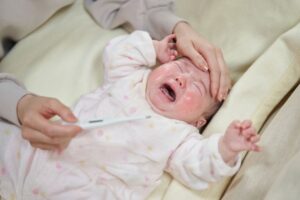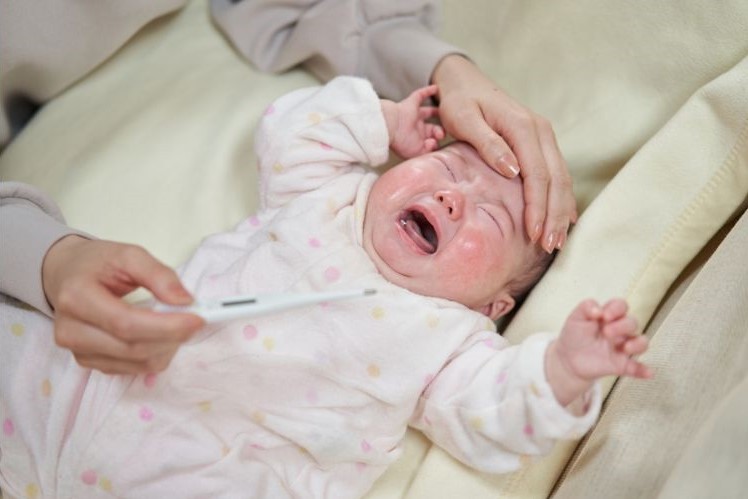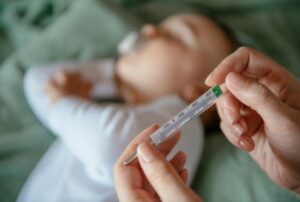 Something is wrong with your newborn. While your newborn typically loves to eat, they will not take a bottle or breastfeed. They don’t seem interested even when you make their favorite toy dance in front of their eyes. And while you’re trying to comfort them, their skin feels feverish. Is it a fever?
Something is wrong with your newborn. While your newborn typically loves to eat, they will not take a bottle or breastfeed. They don’t seem interested even when you make their favorite toy dance in front of their eyes. And while you’re trying to comfort them, their skin feels feverish. Is it a fever?
You become concerned for your youngster when they do not seem normal. You’re also concerned if you believe your child has a fever, especially if you’re a parent. It’s natural to fear being sick rather than seeing your kid sick.
Try your best to relax. Every baby will have a fever at some point during their young years, and most high temperatures are modest and manageable at home.
Still, it’s critical to be aware of the signs of high temperature in children, how to take their temperature, what constitutes a high temperature, and when to contact your baby’s doctor or go to the emergency room for fever symptoms.

Table of Contents
What is a Baby Fever, and What Triggers Them?
The body’s inner “thermostat” raises the temperature above average in response to an infection. This thermostat is found in the hypothalamus, a brain region that recognizes what temperature your body should be at (usually around 98.6°F/37°C).
Most people’s temperatures vary somewhat throughout the day: It is generally slightly lower in the early morning and higher at night, with fluctuations dependent on children’s activities.
Sometimes, however, the hypothalamus will “reset” the body to a higher temperature in response to an infection, sickness, or other cause. What’s going on? According to experts, raising the temperature makes it harder for bacteria that cause infections to thrive.
It’s crucial to remember that high temperatures aren’t inherently harmful; instead, they’re usually a symptom of another issue.
Fevers can be triggered by a couple of points, including:
The causes of most fevers are newly emerging infections. Viruses create 10 times as many infections as bacteria. The hundreds of germs that can cause an infection exists and only a handful of typical ones would be recognized.
- Overheated. The fever is generally a lesser grade. It’s possible to be over-clad and suffer from it. The temperature will return to normal in a few hours after being transferred to a cooler environment. With rest and hydration, the fever disappears quickly.
- Vaccine Fever. A fever begins with many vaccinations between 12 and 24 hours after they are given. It lasts two to three days. This is typical, as well as safe. It indicates the vaccine is effective.
- Bacterial Infections. The most typical cause of hidden fever in women is a bladder infection. Strep throat is also a usual cause of inexplicable fever.
- Viral Infections. Colds, the flu, and other viral infections are some of the most prevalent causes. Fever may be the only symptom for the first 24 hours. Viral symptoms (drippy nose, cough, loose stools) generally appear later than normal. The case of Roseola is one of the most severe. For 3 to 5 days, high temperature may be the only indication. A rash subsequently appears.
- Newborn Fever (Significant). Fever that occurs in the first three months of life is potentially dangerous. Every one of these infants, regardless of their age, must be examined as soon as possible. Blood poisoning (a bloodstream infection) might blame for the high temperature. At this age, infections caused by germs can quickly get worse. They require urgent treatment.
- Meningitis (Really Significant).A bacterial infection of the membrane that covers the spinal cord and brain. The most common symptoms are a stiff neck, a headache, and mental confusion. Young children tend to be cranky because they can’t be comforted. If left untreated, this condition may result in brain damage.
Fever in Babies: What Are the Signs?
Your baby may react distinctively, and they could be more irritable and fussy than usual.
Other signs of a fever in infants include:
- Sweats profusely
- Poor resting
- Convulsions or seizures
- Poor eating
- Adjustment in behavior or activity level.
- Lack of interest in play
- Less energetic or perhaps sluggish
- Warmer
- Flushed
- Thirstier
When is it a Fever for a Baby?
To confirm a fever, use an accurate electronic thermometer. It’s a fever when a baby’s temperature reaches one of these values:
Measured in an axillary position (under the arm): 99 ° F( 37.2 ° C).
Measured rectally (in the bottom): 100.4 ° F( 38 ° C).
Measured by mouth at 100 ° F( 37.8 ° C).
A fever’s intensity does not tell you much about your child’s health. Mild cold or other viral infection can regularly raise a temperature (in the 102°104° Fahrenheit/38.9 °C to 40.0 ° C range); however, this does not always indicate there is a significant problem. In fact, a severe infection, especially in infants, may go unnoticed because the individual has no fever or even a low body temperature (below 97°F or 36.1°C).
A baby’s fever may fluctuate; therefore, a youngster might experience chills as the body temperature increases. When the temperature drops, the kid may sweat to release extra heat.
Occasionally, babies with a fever breathe quicker than usual and have a faster heart rate. See a doctor if your kid has difficulty breathing, is rapidly above normal, or is still taking short breaths after the high temperature has subsided.
How to Check a Baby’s Temperature

Depending on how you’re taking your child’s temperature, you’ll need to follow a different set of instructions. To ensure that you’re using the thermometer correctly, double-check the instructions that came with it. There are four methods to check your baby’s temperature:
- Oral
- Underarm
- Rectal
- Ear (not preferred method)
The following are suggestions for ensuring that the thermometers are used correctly:
Oral temperature:
- After your kid has had a drink or meal, wait 15 minutes before taking their temperature.
- Rinse the end of the thermostat with lukewarm water or alcohol, then use cold water to completely dry it.
- Turn on the thermometer and carefully place the tip under their tongue against the back of her mouth. Hold it in position until you hear a beep.
Underarm temperature:
- Rinse the end of the thermostat with lukewarm water or alcohol, then use cold water to completely dry it.
- Turn on the thermostat and place it under your child’s bare underarm. Always make sure it’s in direct contact with skin rather than clothing.
- Hold your kid’s arm in place until you hear a beep.
Rectal temperature level:
- Rinse the thermostat with warm water or alcohol, then cool and dry it thoroughly.
- Dab a tiny bit of lubricant on the tip
- Place your toddler on their stomach (on a firm surface area, like an altering pad or across your lap) and firmly yet gently restrain them by putting your palm against their lower back. You may also place your kid face up and flex their legs to their chest while relaxing your free hand against the backs of their upper legs if this isn’t comfortable.
- Utilize your free hand to turn the thermometer on and insert it into the anus. Do not do more than 1 inch. To keep the thermometer in place, cover your child’s bottom with one hand and hold it gently with your fingers.
- Pay attention to the beep, and then remove it.
- After each usage, clean the thermometer and always check to ensure it’s clean.
Ear temperature:
- Rinse the end of the thermostat with lukewarm water or alcohol, then use cold water to completely dry it.
- Cover the end of the thermostat with a neat cover.
- After that, pull your youngster’s ear back and carefully insert the thermostat in their ear canal. Direct the probe toward your youngster’s other eye on the other side of their head. Remember that getting the angle correct for an exact evaluation may be challenging; this is why ear thermostats are not suggested for infants and younger children.
- Turn on the thermometer, wait for the beep, then take it out.
What Should I Do If My Baby Has a Fever?
 Not all fevers require treatment, and a fever should be treated only if it is causing discomfort to a child in most circumstances.
Not all fevers require treatment, and a fever should be treated only if it is causing discomfort to a child in most circumstances.
The symptoms that frequently accompany a fever may be relieved using the following strategies:
Resting.
Make sure your child gets enough rest. It’s unnecessary to stay in bed all day, but a sick child should rest.
Keeping a child with a high fever at home from college or childcare is highly advised. According to most doctors, it’s perfectly safe to return when the temperature has been normal for one day.
Diet and Hydration
To prevent dehydration, stock up on various liquids to keep from losing fluids quickly. Water, soup, and ice are excellent options, and flavored gelatin is particularly appealing. Avoid caffeine-rich beverages, such as sodas and tea, since they can worsen dehydration by increasing urination (peeing).
If your kid is vomiting and/or having diarrhea, consult your doctor to see if you should give an electrolyte (rehydration) solution designed specifically for children. You can get them at pharmacies as well as supermarkets. Sports drinks, however, should be avoided since they aren’t intended for youngsters, and the sugar may worsen diarrhea. Limiting your child’s fruit and apple juice intake is also a good idea.
Medicines.
No medicines should be given to an infant under two months old without being examined by a doctor. If your kid has any medical issues, consult your doctor about which medicine is appropriate. It’s critical to remember that fever medicine might cause a fever to drop for a time, but it will not raise it back to normal and won’t treat the underlying cause of the madness.
If your youngster is fussing or unhappy, you may give them acetaminophen or Advil based on the age- or weight-specific package directions. (Unless instructed by a doctor, Never offer aspirin to a youngster, even if they feel sick. Reye syndrome, an uncommon but potentially deadly illness, is linked with aspirin administration.) If you don’t know the suggested dosage or your child is younger than two years old, contact a doctor to figure out how much to give.
Home Comfort
They should be kept warm in a lightweight outfit and covered with a light cover, such as a sheet or blanket. Overdressing and over bundling can prevent body heat from escaping and raising the temperature.
Check the temperature in your child’s bedroom to make sure it is a comfortable temperature—not too warm or cold.
Some parents and guardians use lukewarm sponges in bathrooms to lower a fever, but they only aid for a short time. Sponge bathrooms are really difficult for children. Avoid ice packs and icy baths. Make use of neither scrubbing alcohol (which might be absorbed through the skin) nor ice packs/cold bathing (since these may cause colds, which can raise body temperature).
In general, allow children to eat what they want (in reasonable portions), but do not compel them if they don’t wish to.
When Should You Call or Visit Your Doctor?
The exact temperature that requires a child to see the doctor is determined by age and illness.
Call your doctor if you’re experiencing any of the following symptoms:
- A baby younger than three months old with a rectal temperature of 100.4°F (38°C) or greater
- an older child with a temperature higher than 102.2 ° F( 39 ° C).
If your youngster has a fever of less than 102.2°F (39°C), or if an older youngster has a fever of lower than 102.2°F (39 ° C) with signs and symptoms such as:
- Hasn’t peed much in the past 24 hours, has not had tears when crying, and is less alert and active than usual.
- Has discomfort while peeing.
- The individual refuses liquids or appears to be unable to hydrate correctly.
- If you have frequent, severe stomach upset and continual vomiting or diarrhea
- has rash
- Still has a high fever after 24 hours (in babies younger than 2 years of age) or 72 hours (in babies over two years old).
- Has persistent fevers that are on and off, even if they last a couple of hours each evening.
- has a sore throat or earache
- If they have a pre-existing medical condition such as heart disease, cancer cells, lupus, or sickle cell disease
If your baby displays any of these warning signs, get emergency care:
- Moderate to severe stubborn belly discomfort.
- non-stop crying
- Leaning forward and also drooling.
- Extreme irritability or fussiness.
- Sluggish as well as trouble awakening.
- Extreme migraine.
- The center of the glans is visible, although the pinkish-pink area surrounding it (a “breakout”) or purple areas that appear like contusions on the skin (that were not there previously during their illness) may be noticeable.
- Blue lips, tongue, or nails.
- The soft spot on the top of the baby’s skull appears to be bulging out or sunken in.
- Stiff neck.
- limpness or refusing to move
- Seizure.
- The child has trouble breathing that doesn’t go away when the nose is cleared.
Also, inquire whether your medical professional has any restrictions on when to notify you about a fever.
Final Thought — Baby Fever
Fever is something that all children experience, and they usually return to normal in a few days. For older infants and youngsters, the person’s behavior may be more significant than the temperature on your thermometer. When you have a fever, everyone becomes testy. This is entirely natural, and it must be anticipated.
However, if you’re ever unsure what to do, whether a fever means anything, or if your child’s acting strangely although there isn’t a temperature, always contact your doctor for advice.

